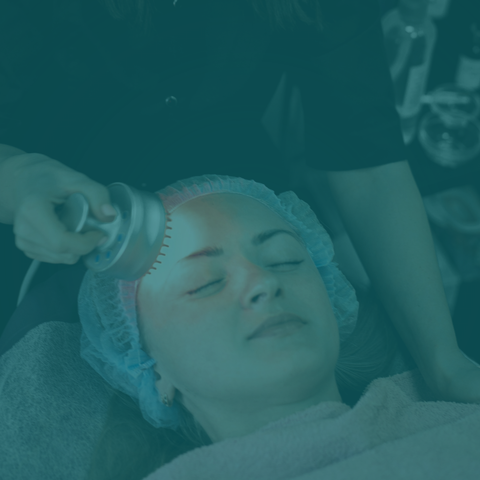
Testosterone is a vital hormone that is central to muscle mass, energy, libido, mood, and overall health in men. After age 30, testosterone levels decline at a rate of around 1 to 2% per year, which can contribute to fatigue, weight gain, lower motivation, and impaired sexual health [1]. Since the 1970s, there has been a significant decline in serum testosterone that is independent of age and likely associated with other factors such as lifestyle and the environment [2-4].
While testosterone replacement therapy, or TRT, has grown in popularity in recent years [5], many men are seeking natural, non-pharmacological methods to optimize their hormone levels.
One emerging tool that is generating considerable interest is red light therapy (RLT), also called low-level light therapy (LLLT) or photobiomodulation [6]. The idea that shining red or near-infrared light on the body could influence hormone production sounds almost too good to be true.
In this article, we will take a look at the evidence suggesting that there could be a connection between light exposure and testosterone production.
What is Red Light Therapy?
Photobiomodulation is a process wherein the absorption of red light energy produces a series of physiological effects at the cellular level. These include the enhancement of adenosine triphosphate (ATP, the cell’s energy currency) production in mitochondria, cell signaling and growth factor synthesis, and the reduction of oxidative stress. It is an increasingly popular therapy for treating skin conditions, especially those associated with the signs of skin aging [7].
Red light therapy typically uses wavelengths of between 600-1000 nm, falling in the red to near-infrared spectrum. These wavelengths penetrate the skin and are absorbed by mitochondria, the energy-producing organelles in our cells.
The absorption of red/near-infrared light energy, a process termed "photobiomodulation," enhances mitochondrial ATP production, cell signaling, and growth factor synthesis, and attenuates oxidative stress. Photobiomodulation is now highly commercialized with devices marketed directly to the consumer. Nevertheless, harnessing the clinical potential of LLLT in a scientifically robust way remains a challenge [6].
The Biological Link Between Red Light Therapy and Testosterone Levels
Testosterone is produced by Leydig cells in the testes, which convert cholesterol into testosterone via luteinizing hormone [8,9].
Interestingly, Leydig cells are rich in mitochondria, meaning they are highly sensitive to changes in cellular energy status. Early evidence from an animal study has shown that photobiomodulation therapy was associated with significant improvements in testosterone levels and a reversal of testicular cell loss [10-12]. It must be noted, though, that these animals were not healthy; rather, they had experienced a spinal cord injury, which can itself lead to reproductive health problems in males, and/or were subjected to heat stress.
In a separate study on testicular degeneration in rams, LLLT did not improve testosterone concentration [13].
Emerging Human Evidence
A few small studies and anecdotal reports hint at a potential connection between light therapy and testosterone levels in humans, but a direct link is yet to be robustly demonstrated.
One study in humans has shown that two weeks of light therapy (not strictly red light) improved sexual satisfaction compared with a placebo, but these findings were not correlated with testosterone levels during the conduct of the study [14].
A separate study on full-body photobiomodulation therapy and its potential impact on reducing inflammation and muscle damage in male water polo athletes found no effect on testosterone during repeated days of water polo matches [15].
Despite the existence of many anecdotal reports of red light therapy improving libido, energy, and subjective wellness, a direct link has not been demonstrated between this therapy and testosterone levels in robust human research trials.
Are There Any Systemic Benefits Beyond Testosterone?
Red light therapy might offer several benefits that indirectly support hormonal health, such as improved sleep [16] (enhances recovery and hormonal balance), reduced inflammation [17] (chronic inflammation suppresses testosterone), and more efficient mitochondria [18,19], which support vitality and resilience.
Enter Methylene Blue: A Potential Synergy?
Methylene blue is a century-old compound originally used as a dye and medical treatment for methemoglobinemia. In recent years, it has garnered attention as a mitochondrial booster and neuroprotective agent that holds some promise when used in synergy with near-infrared light [20].
Only scant research has paired methylene blue administration with photobiomodulation in animals [21], and only one study of note in humans that focused on COVID-19 management [22]. The testosterone-specific work is yet to be accomplished, but if the mitochondria are the engines or hubs of steroid hormone production, then combining two mitochondrial enhancers could theoretically amplify testosterone output.
You can read more on methylene blue and red light therapy here.
Conclusion
Red light therapy is an intriguing, non-invasive tool for men interested in supporting testosterone and overall vitality. While human studies are still limited, the biological mechanisms and early findings are encouraging.
The potential applications of two mitochondrial enhancers — light and a redox-active compound like methylene blue — could potentially drive cellular energy and hormone production further than either therapy in isolation.
Of course, more clinical trials are needed before definitive claims can be made. However, for those exploring science-backed, low-risk strategies to boost vitality, the combination of red light therapy and methylene blue could represent one of the more exciting frontiers in natural hormone optimization.
Check out some of our other blogs around testosterone (and myths!) and light therapy:
References
[1] G. Corona, M. Maggi, The role of testosterone in male sexual function, Rev Endocr Metab Disord 23 (2022) 1159–1172. https://doi.org/10.1007/s11154-022-09748-3.
[2] G. Chodick, S. Epstein, V. Shalev, Secular trends in testosterone- findings from a large state-mandate care provider, Reprod Biol Endocrinol 18 (2020) 19. https://doi.org/10.1186/s12958-020-00575-2.
[3] T.G. Travison, A.B. Araujo, A.B. O’Donnell, V. Kupelian, J.B. McKinlay, A Population-Level Decline in Serum Testosterone Levels in American Men, The Journal of Clinical Endocrinology & Metabolism 92 (2007) 196–202. https://doi.org/10.1210/jc.2006-1375.
[4] H. Cheng, X. Zhang, Y. Li, D. Cao, C. Luo, Q. Zhang, S. Zhang, Y. Jiao, Age-related testosterone decline: mechanisms and intervention strategies, Reprod Biol Endocrinol 22 (2024) 144. https://doi.org/10.1186/s12958-024-01316-5.
[5] P.M. Luther, N.J. Spillers, N.C. Talbot, E.S. Sinnathamby, D. Ellison, R.A. Kelkar, S. Ahmadzadeh, S. Shekoohi, A.D. Kaye, Testosterone replacement therapy: clinical considerations, Expert Opinion on Pharmacotherapy 25 (2024) 25–35. https://doi.org/10.1080/14656566.2024.2306832.
[6] G.E. Glass, Photobiomodulation: The Clinical Applications of Low-Level Light Therapy, Aesthetic Surgery Journal 41 (2021) 723–738. https://doi.org/10.1093/asj/sjab025.
[7] V. Couturaud, M. Le Fur, M. Pelletier, F. Granotier, Reverse skin aging signs by red light photobiomodulation, Skin Research and Technology 29 (2023) e13391. https://doi.org/10.1111/srt.13391.
[8] T. Lei, Y. Yang, W.-X. Yang, Luteinizing Hormone Regulates Testosterone Production, Leydig Cell Proliferation, Differentiation, and Circadian Rhythm During Spermatogenesis, IJMS 26 (2025) 3548. https://doi.org/10.3390/ijms26083548.
[9] O.O. Oduwole, I.T. Huhtaniemi, M. Misrahi, The Roles of Luteinizing Hormone, Follicle-Stimulating Hormone and Testosterone in Spermatogenesis and Folliculogenesis Revisited, IJMS 22 (2021) 12735. https://doi.org/10.3390/ijms222312735.
[10] H. Taheri, H.R. Mosleh, S. Jahanbaz, A. Aliaghaei, F. Tahmasebinia, M. Abedi, S. Abbasi, H.-A. Abbaszadeh, Therapeutic Effects of Low-Level Laser Therapy on Rat Spinal Cord Injury: Analysis of Inflammatory Markers and Testicular Function, J Lasers Med Sci 16 (2025) e6. https://doi.org/10.34172/jlms.2025.06.
[11] F. Aghajanpour, H.-A. Abbaszadeh, H. Nazarian, A. Afshar, R. Soltani, H. Bana Derakhshan, F. Fadaei Fathabadi, M. Norouzian, Photobiomodulation Improves Histological Parameters of Testis and Spermatogenesis in Adult Mice Exposed to Scrotal Hyperthermia in the Prepubertal Phase, J Lasers Med Sci 15 (2024) e49. https://doi.org/10.34172/jlms.2024.49.
[12] F. Aqajanpor, B.J. Kondori, M.H. Asadi, M. Raei, M.G. Nezhadian, H. Bahadoran, Photobiomodulation is more effective than long-term scrotal hyperthermia in improving testis tissue and spermatogenesis in mice with busulfan-induced azoospermia, Clin Exp Reprod Med 52 (2025) 283–294. https://doi.org/10.5653/cerm.2024.07430.
[13] M.B.R. Alves, R.P. De Arruda, L. Batissaco, S.A. Florez-Rodriguez, B.M.M. De Oliveira, M.A. Torres, G.M. Ravagnani, R. Lançoni, T.G. De Almeida, V.M. Storillo, V.S. Vellone, C.R. Franci, H.E. Thomé, C.L. Canella, A.F.C. De Andrade, E.C.C. Celeghini, Low-level laser therapy to recovery testicular degeneration in rams: effects on seminal characteristics, scrotal temperature, plasma testosterone concentration, and testes histopathology, Lasers Med Sci 31 (2016) 695–704. https://doi.org/10.1007/s10103-016-1911-1.
[14] L. Bossini, C. Caterini, D. Koukouna, I. Casolaro, M. Roggi, S. Di Volo, F. Fargnoli, R. Ponchietti, J. Benbow, A. Fagiolini, [Light therapy as a treatment for sexual dysfunctions--beyond a pilot study], Psychiatr Pol 47 (2013) 1113–1122.
[15] A.M. Zagatto, Y.M. Dutra, F.S. Lira, B.M. Antunes, J.B. Faustini, E.D.S. Malta, V.H.F. Lopes, R.A.B. De Poli, G.M.P. Brisola, G.V. Dos Santos, F.M. Rodrigues, C. Ferraresi, Full Body Photobiomodulation Therapy to Induce Faster Muscle Recovery in Water Polo Athletes: Preliminary Results, Photobiomodulation, Photomedicine, and Laser Surgery 38 (2020) 766–772. https://doi.org/10.1089/photob.2020.4803.
[16] R. Pan, G. Zhang, F. Deng, W. Lin, J. Pan, Effects of red light on sleep and mood in healthy subjects and individuals with insomnia disorder, Front. Psychiatry 14 (2023) 1200350. https://doi.org/10.3389/fpsyt.2023.1200350.
[17] M.R. Hamblin, Mechanisms and applications of the anti-inflammatory effects of photobiomodulation, AIMS Biophysics 4 (2017) 337–361. https://doi.org/10.3934/biophy.2017.3.337.
[18] M.B. Powner, G. Jeffery, Light stimulation of mitochondria reduces blood glucose levels, Journal of Biophotonics 17 (2024) e202300521. https://doi.org/10.1002/jbio.202300521.
[19] C. Ferraresi, B. Kaippert, P. Avci, Y. Huang, M.V.P. De Sousa, V.S. Bagnato, N.A. Parizotto, M.R. Hamblin, Low‐level Laser (Light) Therapy Increases Mitochondrial Membrane Potential and ATP Synthesis in C2C12 Myotubes with a Peak Response at 3–6 h, Photochem & Photobiology 91 (2015) 411–416. https://doi.org/10.1111/php.12397.
[20] F. Gonzalez-Lima, A. Auchter, Protection against neurodegeneration with low-dose methylene blue and near-infrared light, Front. Cell. Neurosci. 9 (2015). https://doi.org/10.3389/fncel.2015.00179.
[21] R. Meynaghizadeh-Zargar, S. Sadigh-Eteghad, G. Mohaddes, F. Salehpour, S.H. Rasta, Effects of transcranial photobiomodulation and methylene blue on biochemical and behavioral profiles in mice stress model, Lasers Med Sci 35 (2020) 573–584. https://doi.org/10.1007/s10103-019-02851-z.
[22] J. Hepburn, S. Williams-Lockhart, R.J. Bensadoun, R. Hanna, A Novel Approach of Combining Methylene Blue Photodynamic Inactivation, Photobiomodulation and Oral Ingested Methylene Blue in COVID-19 Management: A Pilot Clinical Study with 12-Month Follow-Up, Antioxidants 11 (2022) 2211. https://doi.org/10.3390/antiox11112211.





Comments (0)
There are no comments for this article. Be the first one to leave a message!